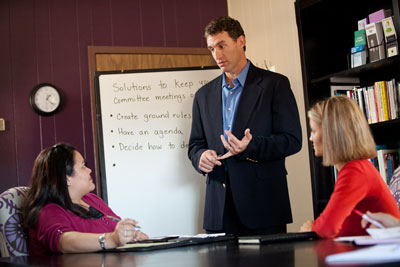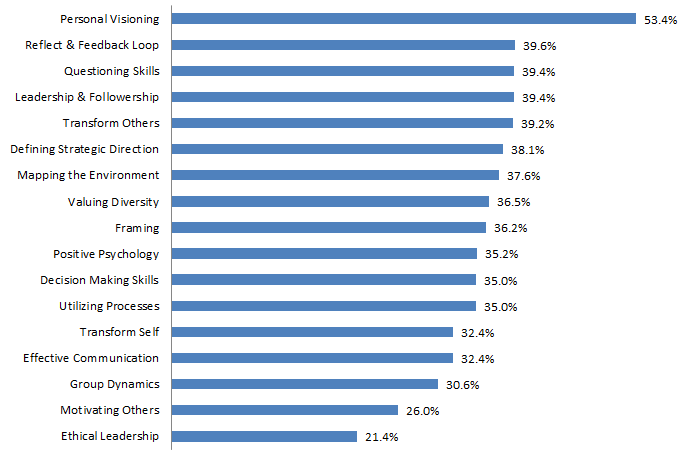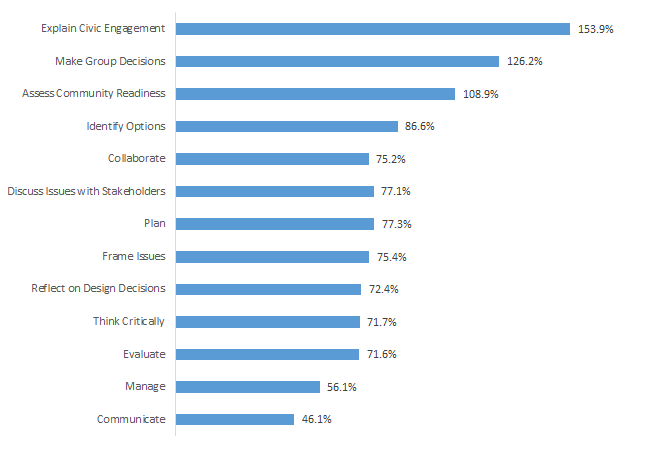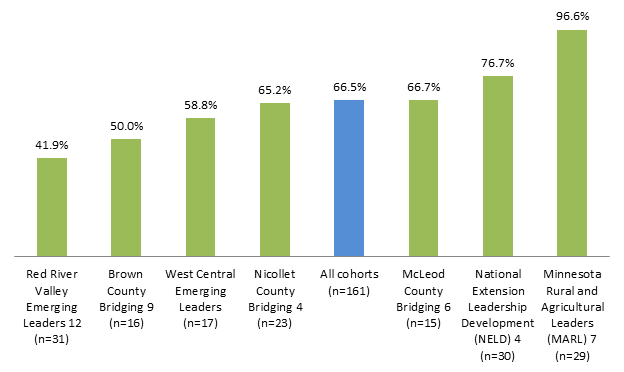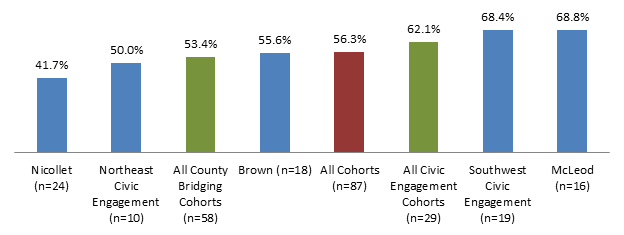I've put my discoveries to work helping three communities prepare their voting precincts for the future.— Barb Boch Laabs, U-lead advisory academy (ULAA), 2016
How we evaluate our programs
Extension routinely studies the effectiveness of its leadership and civic engagement programs. Our goal is to understand whether or not our programs:
- Strengthen participant leadership skills and knowledge
- Increase participant leadership within communities
- Create stronger communities
Evaluating skills and knowledge
Extension's leadership programs focus on skills and knowledge that help participants lead teams, solve problems and make a difference in communities. Post-program assessments show strong increases in knowledge and skills related to the following competencies*
Leadership competencies
Civic engagement competencies
*Data presents the percentage of increase, as measured by retrospective pre-post surveys in three civic engagement cohort programs, regarding key skills that create positive civic engagement experiences in communities.
Evaluating leadership
I will become more involved in my community. No more staying behind the scenes.— Tina Swanson, emerging leadership program, 2016
Extension research fellow Ben Winchester conducted a 2010 study showing the demand for leaders in Minnesota. He found the need for leaders is nearly five times greater in rural areas than in urban areas.
These rural counties need 1 in 34 residents to serve in leadership positions. In metropolitan areas, the need is 1 in 143 residents. In 2014, we collected information from 161 participants of seven leadership cohort programs. We compared the level and number of leadership roles reported at the beginning of the program to the level and number at the end. Results are below.
Growing involvement
Percent of 2014 program participants who increased their involvement in at least one of their organizational roles
Evaluating community strength
Connections to each other and other communities can help bring new ideas and resources to communities. Extension's leadership and civic engagement programs intentionally create these connections.
Increased connections to new groups and people
Percentage of participants in county bridging or civic engagement cohort programs that increased connections to new groups and people, as measured by pre- and post-survey results.
Extension evaluates the impact of leadership and civic engagement programs by using the community capitals (Flora, et. al., 20081) and public value (Kalambokidis, 2004; Chazdon & Paine, 20142) frameworks. Program participants and other community stakeholders are invited to participate in Ripple Effect Mapping sessions. During these sessions, they reflect on the chain of effects of the programs in their communities3.
While an Extension program may not be the sole cause of all reported outcomes, participants could name a specific contribution the program made toward most of them. These outcomes are categorized into "community capitals" known to create thriving communities.
Community capitals
- Human
- Changes in knowledge, attitudes, or skills among organization or community members.
- Civic/Political
- Increased ability of organizations or communities to mobilize public engagement or influence the distribution of public resources.
- Social
- Strengthened or expanded trust or connections among people, groups and organizations.
- Financial
- Increased private and public wealth that is invested in the well-being of organizations or communities.
- Cultural
- Strengthening the ability of organizations or communities to support and celebrate diverse worldviews, and to transmit knowledge of cultural heritage to future generations.
- Built
- Improvement of structures and infrastructures that contribute to the well-being of organizations or communities.
- Natural
- Strengthening the ability of organizations or communities to protect the landscape, air, water, soil, and biodiversity of both plants and animals.
- Health
- Increased the ability of organizations or communities to promote physical, mental, or spiritual well-being.
In 2014, ripple effect maps showed the effects of two leadership and civic engagement cohort programs — the Minnesota Agriculture and Rural Leaders' (MARL) Program and the Water Quality Civic Engagement cohort in Southwest Minnesota. MARL program alumni credited the program with 61 outcomes for their communities.
Community effects of MARL program
Community capitals as reported by participants and community stakeholders.
Human: 28
Examples:
- Experiencing a broader understanding of domestic and global issues, particularly related to agriculture
- Knowing how to make business changes and successfully implement "servant leadership"
- Having the confidence to work through conflict
Civic/Political: 21
Examples:
- Receiving a seat on the school board
- Becoming more active in the community and running for city council
- Ability to have more civil conversations by better seeing others' perspectives; becoming a better listener; having increased confidence to lead difficult projects effectively
- Helping other people solve problems
Social: 13
Examples:
- Helping improve the relationship with union and city workers
- Having the confidence to become a more active leader
- Having the ability to draw upon a wealth of knowledge
- Networking with leaders of different stakeholder groups and organizations
Financial: 7
Examples:
- Identifying synergies between pork, beef and dairy industries around things like feed
- Working on purchase cooperatives for schools
- Collaborating with a local grocery owner to keep the store open
- Having more confidence to lead effectively, especially during difficult projects
- Listening and being able to see other perspectives better
Cultural: 4
Examples:
- Taking on the role of the other and respecting people and their differences
- Experiencing all levels of wealth during a trip abroad
Built: 4
Example: creating a 20-megawatt wind farm in Southwest Minnesota
Natural: 1
Example: creating a 20-megawatt wind farm in Southwest Minnesota
Community effects of the Southeast Minnesota Civic Engagement Cohort
Community capitals as reported by participants and community stakeholders.
Civic/Political: 30
Examples:
- Building a three-county "Citizen Summit"
- Creating stronger connections between state and local agencies working on water quality
- Experiencing more effective participation rather than just hearing from a few loud voices
Social: 27
Examples:
- Connecting with people in the region and forming the coalition selected to be a pilot for the One Watershed One Plan
- Sharing ideas with adjoining watershed
- Interacting with a citizen's group in a more meaningful way
Human: 26
Examples:
- Deepening understanding of the differences and needs at the local level in order to make watershed implementation projects happen
- Realizing how data can be used in technical analysis and communication
- Having more tools in the toolbox for future use
Natural: 17
Examples:
- Creating the Healthy Lake Winona Group (this citizen-led effort is working to remove the lake from the impaired list)
- Becoming more self-sustaining and tackling more challenging problems in watershed citizen's groups
- Experiencing broad participation among citizen summits in Mississippi River-Winona
- Strengthening water management efforts due to stronger citizen support
Financial: 3
Examples:
- Receiving 319 Grant to work together (EPA money through Pollution Control Agency)
- Participating in the Ag Certainty program — Whitewater River Watershed
Health: 1
Examples:
- Starting process of civic engagement with communities in Zumbro watershed
- Providing educational recreation in parks along rivers in the watershed
Built: 1
Example: Posting educational signage in parks throughout the watershed
- 1 Flora, C. B., & Flora, J. L. (2008). Rural communities: Legacy and change. Boulder, CO: Westview Press.
- 2Identifying the public value in Extension programs
- 3Evaluating for public value: Clarifying the relationship between public value and program evaluation


